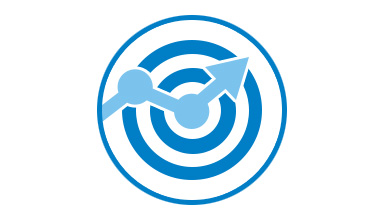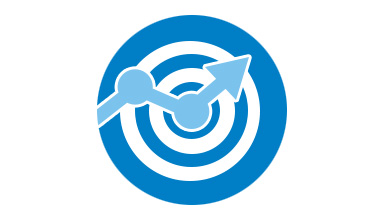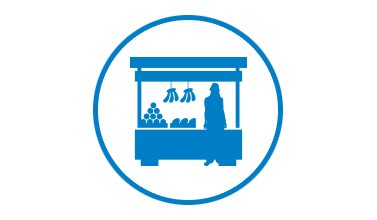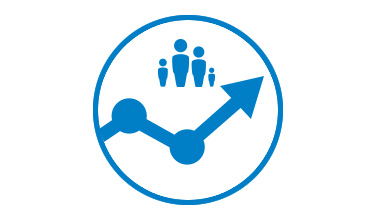How efficient is Hand in Hand, really?
Founded by one of Europe’s best business minds, Hand in Hand has long put efficiency at the core of our work. But with a job creation model few others employ, benchmarking that efficiency has often been difficult.
Now, thanks to two new World Bank studies, that’s beginning to change. Published this year, both studies consider training programmes similar to ours – one in Kenya, the other in Togo – finding significant increases in profit in both cases.
Neither finds gains on par with Hand in Hand’s.
Study one, Kenya: Zero-sum gains?
Is one businesswoman’s gain another’s loss, or does a rising tide lift all boats? That, in effect, is what the World Bank set out to discover when it monitored an International Labour Organization (ILO) business training programme in Kenya broadly similar to Hand in Hand’s. With a sample size of 3,500 micro-enterprises, the randomised experiment measured the business incomes of ILO programme members versus their non-member neighbours, concluding that ”business training can help the overall market grow.” More importantly, for the purposes of this blog, it also discovered that monthly business incomes among programme members were 15 percent higher than among business owners that had not received the training.
Study two, Togo: The psychology of entrepreneurship
A second study, published in Science and featured in The Economist, considered another angle: psychology. Here, researchers from the World Bank, the National University of Singapore and Leuphana University in Germany partnered with the Government of Togo to follow three groups of small business owners who rarely kept books and almost never wrote business plans, earning an average of US $173 a month. The first group, a control group, received no training at all. The second group received training in conventional subjects such as accounting and financial management. The third group received training based on psychological research, designed to teach soft skills such as initiative and persistence.
Those skills, it turns out, are crucial: profits rose by an average of 30 percent among members of the third group. Perhaps more interesting, however, was another finding: the conventional training group saw no uplift at all.
Study three, Rwanda: Hand in Hand
So, how does Hand in Hand stack up?
In the ILO programme in Kenya, business profit was 15 percent higher for programme participants ($86) than non-participants ($75). In the World Bank’s partnership with the Government of Togo, monthly business profit was 30% higher for those that received the psychology base training ($224) compared to those that did not ($173).
And in Hand in Hand’s partnership with CARE in Rwanda, according to an independent study – the most recent, relevant research we have – monthly business incomes were 75 percent higher for those that received the enterprise training ($48) compared to those that did not ($29).
That’s more than double the World Bank’s programme in Togo, and five times the ILO programme in Kenya.
By the numbers
 ILO, Kenya: 15% higher profit for enterprise trainees
ILO, Kenya: 15% higher profit for enterprise trainees
 World Bank, Togo: 30% higher profit for psychology-based training
World Bank, Togo: 30% higher profit for psychology-based training
 Hand in Hand/CARE, Rwanda: 75% higher profit for enterprise trainees
Hand in Hand/CARE, Rwanda: 75% higher profit for enterprise trainees
Hand in Hand Country Manager Stephen Wambua was responsible for running our operation in Rwanda. He credits Hand in Hand’s dual-focus on hard and soft skills with the result.
“Yes, Hand in Hand teaches conventional business skills – our members would be lost without them,” says Stephen. “But our trainers’ capacity to inspire and motivate, along with mutual support among group members, is what makes our model work. It is, for lack of a better term, our ‘secret ingredient’.”
Hand in Hand will continue to seek out quality research to benchmark our programmes. And just as we always have, we’ll keep putting efficiency at the centre of our work.
Beyond Savings: Towards Inclusive Growth – a recap
Last week, Hand in Hand hosted a flagship event at the London School of Economics, ‘Beyond Savings: Towards Inclusive Growth’, bringing together speakers from the worlds of finance and international development. The seminar explored evidence-based solutions to the lack of capital and training that hinders women entrepreneurs in the developing world.
CARE International UK CEO Laurie Lee discussed CARE’s groundbreaking work in financial inclusion for women and adolescent girls, tracing the path from financial exclusion through informal financial inclusion and, finally, formal financial inclusion. Some 1.1 billion women remain unbanked worldwide, he pointed out; NGOs and microfinance institutions (MFIs) have barely scratched the surface.
Download Laurie Lee’s presentation
Hand in Hand International CEO Josefine Lindänge Gutman spoke next, sharing the results from Hand in Hand’s partnership with CARE in Rwanda. From 2013 to 2016, she said, 3,000 pre-existing CARE Savings Groups received Hand in Hand’s business and skills training. The result: business incomes rose by an average of 75 percent, with concomitant increases in asset accumulation and hiring rates. With 10.5 million Savings Groups members worldwide, she concluded, the widespread adoption of business and skills training could be transformational.
Download Josefine Lindänge Gutman’s presentation
Next up was Savings Bank Foundation for International Cooperation (SBIFC) Managing Director Niclaus Bergmann, who provided a banker’s perspective on microfinance, unpacking the tensions between profit-making on one hand and financial inclusion on the other. Because most operational costs (salaries, rent, IT) are fixed, he explained, smaller loans are proportionately more expensive to administer, resulting in higher interest rates for smaller loans. The solution, he continued, is to reduce costs, especially for smaller loans. Bergmann suggested a number of ways this could be done, including: efficient workflows and procedures; economies of scale (e.g. more loans per credit officer); standardized products (amounts, terms, etc.); reduced transaction costs (technology, especially point-of-service terminals); and outsourcing (e.g. cooperation with agents, NGOs and others).
Download Niclaus Bergmann’s presentation
Credit Suisse Global Head of Corporate Citizenship and Foundations Laura Hemrika was the last to speak, presenting financial solutions for linking the top of the global wealth pyramid – that is, the world’s richest people – with the bottom, its poorest. Impact investment, she said, is one means to this end. But how to sell investors on its virtues? Investing in microfinance delivers positive net returns – about 3 to 6 percent a year – with low volatility, said Hemrika, even while guaranteeing a positive social impact. At the same time, she said, impact investment provides portfolio diversification, with small- to medium-sized enterprises operating in comparative detachment from global capital markets.
Download Laura Hemrika’s presentation
Breakout session
Following the presentations, the room split into breakout groups to discuss the night’s talks. Microfinance is well understood, they concluded. So too is the path from savings groups to microfinance institutions taken by Hand in Hand’s beneficiaries and others. But far too little is known about how best to take the next, crucial step from MFIs to bigger traditional lenders.
Click here for a detailed summary of breakout group discussions
With thanks to our sponsor: 
Hand in Hand exceeds targets in Rwanda
Hand in Hand Eastern Africa is “contributing greatly to women’s economic empowerment” in Rwanda, according to a new independent report. Jobs targets in the country have also been vastly exceeded.
Published by independent evaluator DRIS, Bureau d’études et de conseil, the report lends weight to Hand in Hand’s aim, outlined in its 2013-2015 Strategic Plan, to “enter into strategic partnerships in new countries in order to scale up job creation more quickly.”
“Three years ago, we realised that partnering with local NGOs was the quickest, most effective and most sustainable way to reach our goal of creating 10 million jobs,” said Hand in Hand International CEO Josefine Lindänge. “Our experience in Rwanda will help open the door for more partnerships and further expansion in the years to come.”
Hand in Hand launched in Rwanda in 2012. Working with local partner CARE Rwanda, an NGO with years of experience mobilising Self-Help Groups in the country, the plan was to create 80,000 jobs by March 2015. Encouraged by stronger-than-expected results, the program was extended for a year. As of September 2015 – a full seven months before the programme’s conclusion – some 113,650 jobs had been created.
Factors explaining the programme’s success, says the report, include “solid partnerships with local NGOs, an effective supportive supervision system, an effective monitoring system, the complementarity between [CARE] and [Hand in Hand] methodologies and an enabling project environment.”
Other key findings include:
- “The analysis of results show that the most VSLG members were able to hire at least one person and that they are paying their employees in money (98.6%). In the Baseline Study, only 11% of VSLG members reported having hired an employee in the last 12 months.”
- The proportion of group members hiring three, four and five employees is significantly higher (40 percent) among new members (recruited by Hand in Hand) than among previously existing members (27.7 percent).
- Surprisingly, the second highest percentage (17.4 percent) for hiring corresponds to employing six people or more.
- The results show that access to education (98.8 percent) and health insurance (97 percent) is significantly high among group members.
- “Internal loans are being used for consumption and household assets, but also at a remarkable level for business development.”

Businesses started: 78,780
Target: 56,000
Jobs created: 113,662
Target: 80,000

Lives improved: 393,900
Target: 280,000
Hand in Hand teams up with CARE to fight poverty in Rwanda
Hand in Hand International and CARE International are teaming up to fight poverty in Rwanda through grassroots entrepreneurship.
The three-year, US $3.2 million partnership blends the best of both organisations, combining CARE’s experience mobilising savings groups with Hand in Hand’s expertise training rural populations, mostly women, to start their own businesses. The project is expected to create 80,000 jobs.
“The Hand in Hand network aims to create 10 million jobs by 2020. To get there, we need to partner with others,” said Hand in Hand Eastern Africa CEO Pauline Ngari. “Working with CARE represents a huge step forward. Together we can make a real difference.”
John Plastow, CARE International UK’s programme director, agreed.
“CARE has found that community savings groups meet the need for savings and credit at the very bottom rung of the world’s economic ladder. They create a platform from which the poor can advance to receive the more sophisticated financial services that they inevitably need as their resources, skills and confidence grow,” he said. “This partnership is a fantastic opportunity to pool our expertise on savings-led microfinance with Hand in Hand International’s long experience of job creation.”
A CAREing Hand
CARE International has been involved in microfinance since 1991, when the organisation’s team in Niger developed the first Village Savings and Loan Association (VSLA). The model mobilises groups of 10 to 25 members to pool their money, enabling communities overlooked by traditional institutions to access credit. So far, with help from partners including Barclays, the program has benefited more than 3.1 million participants in 34 countries.
Meanwhile, more than 4,500 miles away in rural south India, Hand in Hand developed a savings and enterprise programme of its own: the Job Creation Model. The model is similar to CARE’s but adds an additional element of business training, including help accessing markets, to members of VSLA-style Self Help Groups. To date, more than 1.6 million jobs have been created in 10 countries and counting.
Given both organisations’ common objectives and similar approaches, Hand in Hand International and CARE agreed to establish a partnership to scale up operations in Rwanda.
Why Rwanda?
Rwanda has come a long way since the 1994 genocide claimed some 800,000 lives. According to the World Bank’s 2014 ‘Doing Business’ report the country is second in Africa in terms of overall ease of doing business, while the UNDP reports a 12 percent drop in the poverty rate between 2006 and 2011. But there is still a long way to go. More than 90 percent of the workforce remains engaged in agriculture, often at subsistence levels, and some 25 percent of Rwandans say they’ve gone a full day without a meal in the last three months. It is precisely this mixture of poverty and promise and that makes Rwanda ripe for our programme.
In the Eastern Province districts where our programme is based, only 20 percent of adults polled by Hand in Hand said they had an “income generating activity”, more than a third did not have a mattress, and only 15 percent owned a tool as basic as a pickaxe. In other words, the need for training and finance is urgent.
Our goal
Together, Hand in Hand International and CARE International will do two things: add a business training component to CARE’s existing VSLAs and mobilise thousands more Rwandans to join new ones. The program will draw on technical support from in-country experts and staff from Hand in Hand Eastern Africa, based in neighbouring Kenya. Our ultimate goal is to develop a far-reaching model of job creation in Rwanda, enabling millions of the most disadvantaged people in the country to work their way out of poverty.
To start with, we plan to:
- Create 80,000 sustainable jobs, 60,000 of them for women, by 2015
- Increase household income, savings and asset accumulation amongst VSLA members
- Improve financial knowledge, skills and confidence to make financial decisions amongst VSLA members
- Increase skills to develop small business and income generating activities of VSLA members
